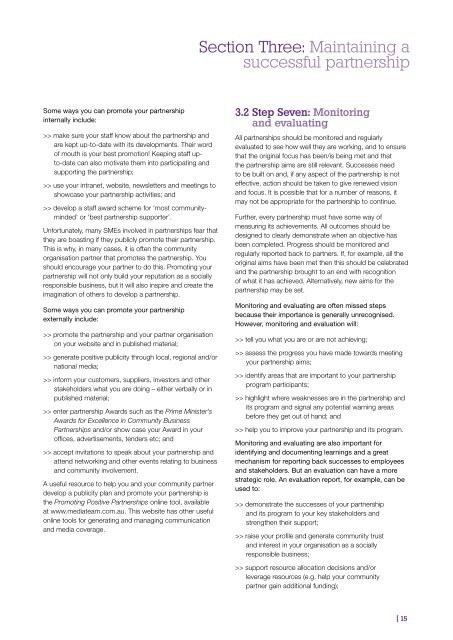partnering with community organisations - Department of Families ...
partnering with community organisations - Department of Families ...
partnering with community organisations - Department of Families ...
Create successful ePaper yourself
Turn your PDF publications into a flip-book with our unique Google optimized e-Paper software.
Section Three: Maintaining a<br />
successful partnership<br />
Some ways you can promote your partnership<br />
internally include:<br />
>> make sure your staff know about the partnership and<br />
are kept up-to-date <strong>with</strong> its developments. Their word<br />
<strong>of</strong> mouth is your best promotion! Keeping staff upto-date<br />
can also motivate them into participating and<br />
supporting the partnership;<br />
>> use your intranet, website, newsletters and meetings to<br />
showcase your partnership activities; and<br />
>> develop a staff award scheme for ‘most <strong>community</strong>minded’<br />
or ‘best partnership supporter’.<br />
Unfortunately, many SMEs involved in partnerships fear that<br />
they are boasting if they publicly promote their partnership.<br />
This is why, in many cases, it is <strong>of</strong>ten the <strong>community</strong><br />
organisation partner that promotes the partnership. You<br />
should encourage your partner to do this. Promoting your<br />
partnership will not only build your reputation as a socially<br />
responsible business, but it will also inspire and create the<br />
imagination <strong>of</strong> others to develop a partnership.<br />
Some ways you can promote your partnership<br />
externally include:<br />
>> promote the partnership and your partner organisation<br />
on your website and in published material;<br />
>> generate positive publicity through local, regional and/or<br />
national media;<br />
>> inform your customers, suppliers, investors and other<br />
stakeholders what you are doing – either verbally or in<br />
published material;<br />
>> enter partnership Awards such as the Prime Minister’s<br />
Awards for Excellence in Community Business<br />
Partnerships and/or show case your Award in your<br />
<strong>of</strong>fices, advertisements, tenders etc; and<br />
>> accept invitations to speak about your partnership and<br />
attend networking and other events relating to business<br />
and <strong>community</strong> involvement.<br />
A useful resource to help you and your <strong>community</strong> partner<br />
develop a publicity plan and promote your partnership is<br />
the Promoting Positive Partnerships online tool, available<br />
at www.mediateam.com.au. This website has other useful<br />
online tools for generating and managing communication<br />
and media coverage.<br />
3.2 Step Seven: Monitoring<br />
and evaluating<br />
All partnerships should be monitored and regularly<br />
evaluated to see how well they are working, and to ensure<br />
that the original focus has been/is being met and that<br />
the partnership aims are still relevant. Successes need<br />
to be built on and, if any aspect <strong>of</strong> the partnership is not<br />
effective, action should be taken to give renewed vision<br />
and focus. It is possible that for a number <strong>of</strong> reasons, it<br />
may not be appropriate for the partnership to continue.<br />
Further, every partnership must have some way <strong>of</strong><br />
measuring its achievements. All outcomes should be<br />
designed to clearly demonstrate when an objective has<br />
been completed. Progress should be monitored and<br />
regularly reported back to partners. If, for example, all the<br />
original aims have been met then this should be celebrated<br />
and the partnership brought to an end <strong>with</strong> recognition<br />
<strong>of</strong> what it has achieved. Alternatively, new aims for the<br />
partnership may be set.<br />
Monitoring and evaluating are <strong>of</strong>ten missed steps<br />
because their importance is generally unrecognised.<br />
However, monitoring and evaluation will:<br />
>> tell you what you are or are not achieving;<br />
>> assess the progress you have made towards meeting<br />
your partnership aims;<br />
>> identify areas that are important to your partnership<br />
program participants;<br />
>> highlight where weaknesses are in the partnership and<br />
its program and signal any potential warning areas<br />
before they get out <strong>of</strong> hand; and<br />
>> help you to improve your partnership and its program.<br />
Monitoring and evaluating are also important for<br />
identifying and documenting learnings and a great<br />
mechanism for reporting back successes to employees<br />
and stakeholders. But an evaluation can have a more<br />
strategic role. An evaluation report, for example, can be<br />
used to:<br />
>> demonstrate the successes <strong>of</strong> your partnership<br />
and its program to your key stakeholders and<br />
strengthen their support;<br />
>> raise your pr<strong>of</strong>ile and generate <strong>community</strong> trust<br />
and interest in your organisation as a socially<br />
responsible business;<br />
>> support resource allocation decisions and/or<br />
leverage resources (e.g. help your <strong>community</strong><br />
partner gain additional funding);<br />
[ 15




![pdf [107kB] - Department of Families, Housing, Community Services](https://img.yumpu.com/51272499/1/190x245/pdf-107kb-department-of-families-housing-community-services.jpg?quality=85)










![Land Claim - pdf [278kB] - Department of Families, Housing ...](https://img.yumpu.com/47002639/1/184x260/land-claim-pdf-278kb-department-of-families-housing-.jpg?quality=85)

![Borroloola Land Claim - pdf [299kB] - Department of Families ...](https://img.yumpu.com/46103973/1/184x260/borroloola-land-claim-pdf-299kb-department-of-families-.jpg?quality=85)